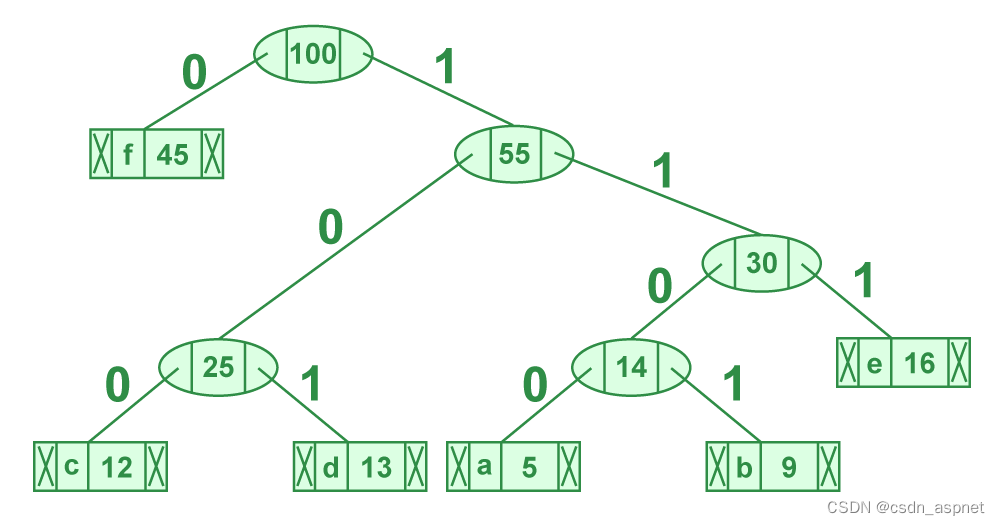
排序输入的高效霍夫曼编码 示例图
建议先阅读下面的文章:
c语言:c语言 霍夫曼编码 | 贪婪算法(Huffman Coding | Greedy Algo)_霍夫曼的贪婪c语言-CSDN博客
c++:c++ 霍夫曼编码 | 贪婪算法(Huffman Coding | Greedy Algo)_霍夫曼的贪婪算法设计核心代码-CSDN博客
c#:C# 霍夫曼编码 | 贪婪算法(Huffman Coding | Greedy Algo)-CSDN博客
c++ STL:c++ STL 霍夫曼编码 | 贪婪算法(Huffman Coding | Greedy Algo)-CSDN博客
java:java 霍夫曼编码 | 贪婪算法(Huffman Coding | Greedy Algo)-CSDN博客
python:python 霍夫曼编码 | 贪婪算法(Huffman Coding | Greedy Algo)-CSDN博客
javascript:JavaScript 霍夫曼编码 | 贪婪算法(Huffman Coding | Greedy Algo)-CSDN博客
上面讨论的算法的时间复杂度是 O(nLogn)。如果我们知道给定的数组是排好序的(按频率非递减顺序),我们可以在 O(n) 时间内生成霍夫曼码。以下是针对已排序输入的 O(n) 算法。
1.创建两个空队列。
2.为每个唯一字符创建一个叶节点,并按频率非递减顺序将其入队到第一个队列。最初第二个队列是空的。
3.通过检查两个队列的前面,使两个频率最小的节点出队。重复以下步骤两次
1. 如果第二个队列为空,则从第一个队列出队。
2. 如果第一个队列为空,则从第二个队列出队。
3. 否则,比较两个队列的前面,并使最小的节点出队。
4.创建一个新的内部节点,其频率等于两个节点频率之和。将第一个出队节点设为其左子节点,将第二个出队节点设为右子节点。将此节点入队到第二个队列。
5.重复步骤 3 和 4,直到队列中有多个节点。剩下的节点就是根节点,树就完成了。
示例代码:
// C Program for Efficient Huffman Coding for Sorted input
#include <stdio.h>
#include <stdlib.h>
// This constant can be avoided by explicitly calculating
// height of Huffman Tree
#define MAX_TREE_HT 100
// A node of huffman tree
struct QueueNode {
char data;
unsigned freq;
struct QueueNode *left, *right;
};
// Structure for Queue: collection of Huffman Tree nodes (or
// QueueNodes)
struct Queue {
int front, rear;
int capacity;
struct QueueNode** array;
};
// A utility function to create a new Queuenode
struct QueueNode* newNode(char data, unsigned freq)
{
struct QueueNode* temp = (struct QueueNode*)malloc(
sizeof(struct QueueNode));
temp->left = temp->right = NULL;
temp->data = data;
temp->freq = freq;
return temp;
}
// A utility function to create a Queue of given capacity
struct Queue* createQueue(int capacity)
{
struct Queue* queue
= (struct Queue*)malloc(sizeof(struct Queue));
queue->front = queue->rear = -1;
queue->capacity = capacity;
queue->array = (struct QueueNode**)malloc(
queue->capacity * sizeof(struct QueueNode*));
return queue;
}
// A utility function to check if size of given queue is 1
int isSizeOne(struct Queue* queue)
{
return queue->front == queue->rear
&& queue->front != -1;
}
// A utility function to check if given queue is empty
int isEmpty(struct Queue* queue)
{
return queue->front == -1;
}
// A utility function to check if given queue is full
int isFull(struct Queue* queue)
{
return queue->rear == queue->capacity - 1;
}
// A utility function to add an item to queue
void enQueue(struct Queue* queue, struct QueueNode* item)
{
if (isFull(queue))
return;
queue->array[++queue->rear] = item;
if (queue->front == -1)
++queue->front;
}
// A utility function to remove an item from queue
struct QueueNode* deQueue(struct Queue* queue)
{
if (isEmpty(queue))
return NULL;
struct QueueNode* temp = queue->array[queue->front];
if (queue->front
== queue
->rear) // If there is only one item in queue
queue->front = queue->rear = -1;
else
++queue->front;
return temp;
}
// A utility function to get form of queue
struct QueueNode* getFront(struct Queue* queue)
{
if (isEmpty(queue))
return NULL;
return queue->array[queue->front];
}
/* A function to get minimum item from two queues */
struct QueueNode* findMin(struct Queue* firstQueue,
struct Queue* secondQueue)
{
// Step 3.a: If first queue is empty, dequeue from
// second queue
if (isEmpty(firstQueue))
return deQueue(secondQueue);
// Step 3.b: If second queue is empty, dequeue from
// first queue
if (isEmpty(secondQueue))
return deQueue(firstQueue);
// Step 3.c: Else, compare the front of two queues and
// dequeue minimum
if (getFront(firstQueue)->freq
< getFront(secondQueue)->freq)
return deQueue(firstQueue);
return deQueue(secondQueue);
}
// Utility function to check if this node is leaf
int isLeaf(struct QueueNode* root)
{
return !(root->left) && !(root->right);
}
// A utility function to print an array of size n
void printArr(int arr[], int n)
{
int i;
for (i = 0; i < n; ++i)
printf("%d", arr[i]);
printf("\n");
}
// The main function that builds Huffman tree
struct QueueNode* buildHuffmanTree(char data[], int freq[],
int size)
{
struct QueueNode *left, *right, *top;
// Step 1: Create two empty queues
struct Queue* firstQueue = createQueue(size);
struct Queue* secondQueue = createQueue(size);
// Step 2:Create a leaf node for each unique character
// and Enqueue it to the first queue in non-decreasing
// order of frequency. Initially second queue is empty
for (int i = 0; i < size; ++i)
enQueue(firstQueue, newNode(data[i], freq[i]));
// Run while Queues contain more than one node. Finally,
// first queue will be empty and second queue will
// contain only one node
while (
!(isEmpty(firstQueue) && isSizeOne(secondQueue))) {
// Step 3: Dequeue two nodes with the minimum
// frequency by examining the front of both queues
left = findMin(firstQueue, secondQueue);
right = findMin(firstQueue, secondQueue);
// Step 4: Create a new internal node with frequency
// equal to the sum of the two nodes frequencies.
// Enqueue this node to second queue.
top = newNode('$', left->freq + right->freq);
top->left = left;
top->right = right;
enQueue(secondQueue, top);
}
return deQueue(secondQueue);
}
// Prints huffman codes from the root of Huffman Tree. It
// uses arr[] to store codes
void printCodes(struct QueueNode* root, int arr[], int top)
{
// Assign 0 to left edge and recur
if (root->left) {
arr[top] = 0;
printCodes(root->left, arr, top + 1);
}
// Assign 1 to right edge and recur
if (root->right) {
arr[top] = 1;
printCodes(root->right, arr, top + 1);
}
// If this is a leaf node, then it contains one of the
// input characters, print the character and its code
// from arr[]
if (isLeaf(root)) {
printf("%c: ", root->data);
printArr(arr, top);
}
}
// The main function that builds a Huffman Tree and print
// codes by traversing the built Huffman Tree
void HuffmanCodes(char data[], int freq[], int size)
{
// Construct Huffman Tree
struct QueueNode* root
= buildHuffmanTree(data, freq, size);
// Print Huffman codes using the Huffman tree built
// above
int arr[MAX_TREE_HT], top = 0;
printCodes(root, arr, top);
}
// Driver program to test above functions
int main()
{
char arr[] = { 'a', 'b', 'c', 'd', 'e', 'f' };
int freq[] = { 5, 9, 12, 13, 16, 45 };
int size = sizeof(arr) / sizeof(arr[0]);
HuffmanCodes(arr, freq, size);
return 0;
}
输出:
f: 0
c: 100
d: 101
a: 1100
b: 1101
e: 111
时间复杂度: O(n)
如果输入未排序,则需要先对其进行排序,然后才能通过上述算法进行处理。排序可以使用堆排序或合并排序来完成,两者都在 Theta(nlogn) 中运行。因此,对于未排序的输入,总体时间复杂度变为 O(nlogn)。
辅助空间: O(n)























 1万+
1万+

 被折叠的 条评论
为什么被折叠?
被折叠的 条评论
为什么被折叠?








